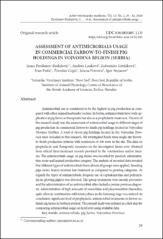| dc.contributor.author | Prodanov-Radulović, Jasna | |
| dc.contributor.author | Lauková, Andrea | |
| dc.contributor.author | Grešáková, Ľubomíra | |
| dc.contributor.author | Pušić, Ivan | |
| dc.contributor.author | Grgić, Živoslav | |
| dc.contributor.author | Petrović, Jelena | |
| dc.contributor.author | Stojanov, Igor | |
| dc.date.accessioned | 2024-03-07T10:43:12Z | |
| dc.date.available | 2024-03-07T10:43:12Z | |
| dc.date.issued | 2020 | |
| dc.identifier.issn | 1820-9955 | |
| dc.identifier.uri | https://repo.niv.ns.ac.rs/xmlui/handle/123456789/766 | |
| dc.description.abstract | Antimicrobial use is considered to be the highest in pig production as com-pared with other animal husbandry sectors. In Serbia, antimicrobials have wide ap-plication at pig farms as therapeutic but also as a prophylactic treatment. Th e aim of the research study was the assessment of antimicrobial usage in diff erent stages of pig production in commercial farrow-to-fi nish pig holdings located in Vojvodina Province (Serbia). A total of eleven pig holdings located in the Vojvodina Prov-ince were included in this research. All investigated herds were single site farrow-to-fi nish production systems with minimum of 300 sows in the site. Th e data on prophylactic and therapeutic measures on the investigated farms were obtained from offi cial farm treatment records provided by the veterinarians and/or farm-ers. Th e antimicrobials usage on pig farms was recorded by product, administra-tion route and animal production category. Th e analysis of recorded data revealed that diff erent types of antimicrobials from almost all groups were applied. Breeding pigs (sows, boars) received less treatment as compared to growing categories. As regards the types of antimicrobials, frequent use of cephalosporins and polymyx-ins in growing piglets was detected. Th e group treatments were mostly preventive and the administration of an antimicrobial oft en lacked a precise previous diagno-sis. Administration of high amounts of macrolides and pleuromutilins (tiamulin), quite oft en in combination with tetracyclines in the fattening stage was noticed. In conclusion, signifi cant level of prophylactic antimicrobial treatments in farrow-to-fi nish pig farms in Serbia is evident. Th e present study was initiated as a fi rst step for comparing antimicrobial usage on herd level using available data. | en_US |
| dc.description.sponsorship | Th is article is based upon work from Scientifi c and Technological coopera-tion between the Republic of Serbia and the Slovak Republic, bilateral project number: 337-00-107/2019-09/14 and SK-SRB-18-0001, project title: Bacteri-ocins, a safe way to inhibit antibiotic resistant bacteria from pigs for healthy farming, supported by the Ministry of Education, Science and Technological Development of the Republic of Serbia, and by APVV agency of Slovak Re-public | en_US |
| dc.language.iso | en | en_US |
| dc.publisher | Scientific Veterinary Institute „Novi Sad“, Novi Sad, Serbia | en_US |
| dc.source | Arhiv veterinarske medicine / Archives of veterinary medicine | en_US |
| dc.subject | antimicrobials | en_US |
| dc.subject | pig farms | en_US |
| dc.subject | Vojvodina Province | en_US |
| dc.title | Assessment of antimicrobials usage in commercial farrow-to-finish pig holdings in Vojvodina region (Serbia) | en_US |
| dc.type | Article | en_US |
| dc.identifier.doi | 10.46784/e-avm.v13i2.243 | |
| dc.citation.volume | 13 | en_US |
| dc.citation.issue | 2 | en_US |
| dc.citation.spage | 29 | en_US |
| dc.citation.epage | 42 | en_US |
| dc.citation.rank | M51 | en_US |
| dc.type.version | published | en_US |

